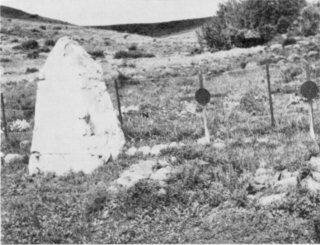

 The South African
The South African
by H.W. Kinsey

9th Lancers monument and graves of Cpl. W. Reder and Pte. R Carthorne of the CMR killed at Bouwershoek, 5th September, 1901.
Col. Scobell managed to secure all the approaches and was aided in his attack by a friendly rainstorm. Lotter was taken by surprise and the commando took cover in a stone-wall sheep kraal from which the men made a valiant stand. No less determined, however, was the assault of the 9th Lancers and the Cape Mounted Riflemen. The Lancers enveloped the laager by a movement on the right, while Captain J. F. Purcell brought the Cape Mounted Riflemen within 300 yards of the farmhouse where Lotter was laagered. Lord Douglas Compton's squadron of the Lancers and Captain Purcell's company of the Cape Mounted Riflemen bore the brunt of the action. These two officers and Lieutenants Wynn and Neilson of the 9th Lancers and Lieutenant Hare-Bowers of the Cape Mounted Riflemen displayed marked gallantry, and are all mentioned as having done so in Lord Kitchener's despatch of 8th September, 1901, in which he describes the capture of Lotter's commando as a brilliant success.
The various accounts of the action differ as to the casualties, but it would appear that the Boers lost about 19 men killed and that about 50 of the 114 men who surrendered were wounded. "The Times History of the War in S.A." states that 18 troopers were killed, but it seems fairly clear from all other accounts that the British lost nine men killed and about 17 wounded. The dead were made up of seven men of the 9th Lancers and two men from the Cape Mounted Riflemen, namely, Corporal W. Reder and Private R. Carthorne.
Captain Purcell received the DSO for his gallant part in the action and Lieutenant Hare-Bowers was mentioned in despatches.
About 200 horses, and a large supply of rifles and ammunition, together with some dynamite, were taken, as well as all the vehicles and supplies of the commando. Commandant Lotter was captured and Field-Cornets J. Kruger, W. Kruger and Schoeman were amongst the prisoners as well as a party of Boers under Breedt. Commandant Lotter was subsequently condemned to death under martial law and was executed at Middelburg in the Cape on 11th October, 1901.
During a recent visit to the Karoo as the guest of Hazel and Martin Short on the historic farm "Wheatlands", I was taken by Hazel's uncle, Mr. Douglas Parkes of the adjoining farm "Klipfontein", to Bouwershoek to visit the old farm where the action took place. The farmhouse is now in ruins but the walls of the sheep kraal may still be clearly seen. Close by is the little military cemetery containing the remains of the seven troopers from the 9th Lancers and the two men from the Cape Mounted Riflemen. The accompanying photograph shows the monument to the men of the Lancers, and the graves of the two Cape Mounted Riflemen. I was informed that the bodies of the Boers had been taken up and moved to the village of Petersburg in 1905, but I was unable to visit the village to see these graves. Nearby the sheep kraal and the cemetery are the well-preserved remains of an old circular stone sheep dip of the type not often seen to-day, whilst the outline of the old threshing floor is still visible.
I was informed later by Mrs. Lilian Parkes, MBE, of "Wheatlands", that Colonel Scobell often came to "Wheatlands" and that she had also met Corporal Reder who was Norwegian. Mrs. Parkes, who is 93 years of age, is the mother of Mr. Douglas Parkes and the grandmother of Hazel Short, and is the grand-daughter of the Wesleyan missionary, the Rev. John Edwards.
The Tandjesberg rises steeply out of the vast expanse of the Karoo and the farm "Bouwershoek" nestles in a secluded grassy valley which seems far removed from the Karoo. When one stands at the old sheep kraal and the cemetery close by one can understand why Commandant Lotter sought refuge there, and how he must have been taken by surprise on that chilly morning of 5th September, 1901.
REFERENCES:
Amery, L. S.: "The Times History of the War in S.A."
Davitt, Michael: "The Boer Fight for Freedom".
Doyle, A. Conan: "The Great Boer War".
Lorch, Maj. A. E.: "A Story of the Cape Mounted Riflemen .
Stirling, John: "Our Regiments in S.A., 1899-1902".
Stirling, John: "The Colonials in SA., 1899-1902".
Young, P. J.: "Boot and Saddle".
Return to Journal Index OR Society's Home page
South African Military History Society / scribe@samilitaryhistory.org